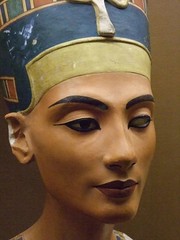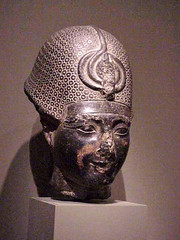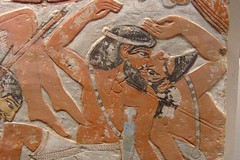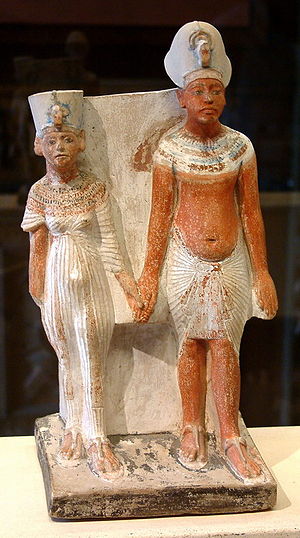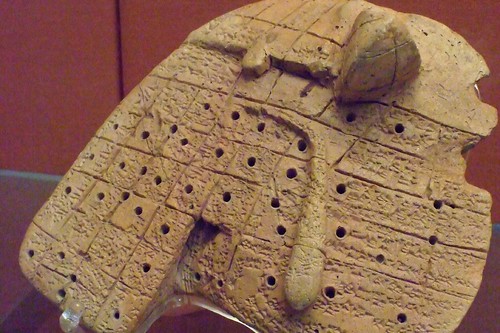"...it is possible to feel fear, confidence, desire, anger, pity, and generally to be affected pleasantly and painfully, either too much or too little, in either case wrongly; but to be thus affected at the right times, and on the right occasions, and towards the right persons, and with the right object, and in the right fashion, is the mean course and the best course, and these are characteristics of virtue." - Aristotle, Nicomachean Ethics

We meet Aristotle on his way to Macedon and find Lyon's philosopher is a rather strange man, who seems content to observe life from the shadows, but not enthusiastically embrace it. He ponders the actions of his wife as if he were musing about the behavior of a neighbor or perhaps a precocious niece, not an object of his own love (although I came to suspect Aristotle did not have the capacity for love). The couple travel with his "nephew" Callisthenes, that we learn is not really his nephew but referred to in that way to avoid unnecessary social speculation. It is obvious from comments exchanged between the older Aristotle and the young Callisthenes that some physical relationship had preceded their current situation but Aristotle makes it clear that the young man is now expected to establish his own household and take up a new life.
 Image via Wikipedia Image via Wikipedia |
| Bust of Aristotle. Marble, Roman copy after a Greek bronze original by Lysippos from 330 BC |
Callisthenes was actually Aristotle's great nephew by way of Aristotle's sister Arimneste. Whether or not the two shared more than ancestors, is not specifically recorded in the ancient sources although the Byzantine encyclopedia known as the Suda states that Palaephatus of Abydos, an historian credited with the titles of Cypriaca, Deliaca, Attica, Arabica was said to be the beloved (eromenos) of Aristotle so like other Greek aristocrats of the period, same-sex relationships were not unknown to him.
As Aristotle reminisces about his youth we learn his father, Nicomachus, was a physician and Aristotle, ever the dutiful son, trailed around after his father, carrying his kit and acting as his assistant when surgery was required. Aristotle gets his first glimpses of internal human anatomy over the shoulder of his father who performs what we would call a Caesarean section on a young woman whose unborn child is lodged in the breech position. Although Aristotle's father stitches the young woman up he explains to his son matter-of-factly that of course the woman will die in a day or two but the child was saved and that is a good day's work. Although Aristotle does not shrink from the experiences encountered with his father, he decides he really does not want to become a physician.
| Phillip II of Macedon, ivory. Courtesy of Livius.org |
The reputation of his father reaches the ears of King Amyntas of Macedon, Phillip II's father, who asks him to become his personal physician. Aristotle's family moves to the Macedonian capital where Aristotle meets Phillip, a boysterous youth with intellect and natural athleticism. I did not know that Aristotle and Phillip knew each other as children. I just thought Phillip asked Aristotle to be Alexander's tutor because of Aristotle's reputation. It isn't directly mentioned in the sources I checked, but it's certainly plausible since Aristotle's father spent so much time at court. I wouldn't exactly call them friends however.
"Ours was an odd friendship, with respect and contempt barely distinguishable. I was smart and he was hard: that was what the world saw and what we saw and liked and disliked in each other. I was not his first friend by any stretch, but he was interested enough in me that I became known around the palace... - Anabel Lyon, The Golden MeanPhillip apparently spent most of his time with his noble companions training to be the consummate warrior while Aristotle, having expressed a desire to learn to write tragedies, is sent to a tutor, a drunken philosopher from the school at Athens who had retreated from the world and now spent his days eternally rewriting a play in a dingy hovel in the poorer neighborhood of the city. The lecherous old geezer uses Aristotle to procure sexual companions for the old man but does manage to impart some of the knowledge he once acquired in the academy as a classmate of Plato.
One day Aristotle returns home to find his father ill and he recognizes the symptoms of plague, a constant risk to men in his father's profession. Aristotle and his siblings are sent away to avoid the contagion but it carries away his parents. Aristotle, who had been invited to study at the academy in Athens, then embarks on his first adventure, to learn at the feet of the famous Plato.
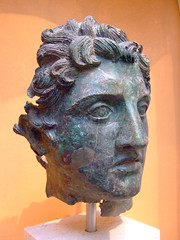 Image by mharrsch via Flickr Image by mharrsch via Flickr |
| Portrait Head of Alexander Roman 1st half of the 3rd century CE Bronze. Santa Barbara (CA) Museum of Art |
Back in the present, Aristotle meets a curious boy of about 13 "with a ruddy face and eyes as big as a calf". This child will become the greatest conqueror in history. But, Lyon's Alexander is a curious boy with a savage edge to him. When Aristotle dissects a chameleon then removes its heart and hands it to Alexander for inspection, the boy pops the bloody organ into his mouth. When the leader of a theater troop apologizes to Aristotle and Alexander for a poorly made fake head that is to be used as a prop in a play to be presented at court, Alexander offers to produce a better one and (spoiler alert) pays a woman to poison another sick actor and hacks his head off. (Aristotle noticed that the actors certainly sounded much more sincere when Alexander tossed them that head during the performance!)
Aristotle is frustrated by Alexander's repeated tardiness and unwillingness to ask questions in class, eventually confronting him and accusing him of a lack of curiosity and intelligence. But Aristotle discovers that Alexander is painfully aware, even at his very young age, of his role as future king and the need to project omniscience to his young companions that will eventually form his officer corps. So, Aristotle arranges private lessons outside of the classroom setting.
Aristotle, as portrayed in this novel, seems to have difficulty deciphering human behavior, perhaps as a side-effect of his introverted personality. He purchases a Scythian slave for his wife and when he asks about her past she relates to him that she was trained as a mid-wife but was forced to try to heal a previous master's sick wife. When she failed and the woman died, the mid-wife was blamed for the death, badly mistreated and eventually sold to a disreputable slave trader. Aristotle assures her that in his household, slaves are considered part of the family and family members are not sold. Later, when Aristotle's wife Pythias becomes seriously ill and he orders the slave to care for her, the slave refuses, pointing out she is only a mid-wife. Aristotle cannot seem to relate her refusal to care for his wife to her previous experience and even though he had told the woman when he brought her into the household that slaves were part of the family and never sold, he drags the woman back to the slave market. He explains to his wife that the woman obviously was never cut out to be a slave and it was ethically wrong to retain her in that position. At the same time he could not free her either because then she would have no place in the world. It was if Aristotle was trapped by his own circular logic and unfortunately, the poor pathetic slave would pay the price for it.
This lack of compassion and inability to understand even his own motivations eventually comes between Aristotle and Alexander as well. Aristotle, though hired to tutor Alexander, encounters Alexander's brain-damaged brother Arrhidaeus and begins to teach him to care for himself and ride a horse. There is no evidence this really occurred but it was a good plot twist to expose the nature of Aristotle and Alexander's intellectual competition. Alexander accuses Aristotle of using Arrhidaeus as one of his projects, not helping his brother out of compassion. It's as if Alexander, even at this young age, has already realized his understanding of human motivations surpasses that of his teacher.
 Image by mharrsch via Flickr Image by mharrsch via Flickr |
| Alexander the Great and his Beloved Companion Hephaistion Side By Side As They Stood in Life at the Getty Villa in Malibu, CA. |
In later years, Alexander would send Aristotle specimens of plants and animals that his forces encountered during their conquest of Persia but the former student and old mentor apparently did not engage in friendly correspondence. Perhaps intellectual rivalry prevented the formation of a closer relationship. Of course it did not help that Aristotle harbored a virulent ethnocentric view of the world, either.
Aristotle advised the young conqueror to be, "...a leader to the Greeks and a despot to the barbarians, to look after the former as after friends and relatives, and to deal with the latter as with beasts or plants'. - Peter Green, Alexander of MacedonThis did not prevent Aristotle from developing a close relationship with Hephaistion, though, and correspondence between Aristotle and Hephaistion was maintained throughout Hephaistion's life. Surprisingly, Lyon did not include any aspect of this relationship in her novel. In fact, Hephaistion played only a very small part in the novel's narrative despite his importance to Alexander and, historically, to Aristotle as well.
A plot development that Lyon did introduce and that I found highly unlikely was Alexander's development of "soldier's heart" after his first major military engagement. Aristotle is called to treat a severe gash on Hephaistion's arm after Alexander apparently suffered a Hollywood-esque flash back and struck out at his closest friend, mistaking him for one of the recently defeated enemy. This definitely heightened the drama of the story but was a literary device that would not have served the character well if the novel had encompassed Alexander's later conquests.
The term soldier's heart is a poetic sounding euphemism for what we today would call post traumatic stress syndrome, sometimes referred to as Da Costa's syndrome. The term is thought to have been coined by physicians during the American Civil War to describe the physical manifestations of stress caused by exposure to combat including left-sided chest pains, heart palpitations, breathlessness, and fatigue in response to exertion.
I personally find it hard to believe that Alexander could have been suffering from what technically would be called acute stress disorder (as it apparently first occurred during or immediately following combat), at least this early in his military career. I don't think Alexander would have been able to astutely assess enemy battle formations and fluidly alter his own offensive strategy to capitalize on his enemies weaknesses in major battles time after time as he historically demonstrated if he had suffered from the disorder. Not only would a condition like "soldier's heart" impair his command decisions, but being in such a trance-like state as Lyon describes, unaware of his real surroundings, would most certainly have proved eventually fatal to not only himself but those under his command as well.
Some scholars believe Alexander and many of his men exhibited the classic symptoms of post traumatic stress syndrome after the battle of Hydaspes, mostly based on the reports of high alcohol consumption which varied significantly between the accounts of Curtius Rufus and Lucius Flavius Arrianus. (Rufus, who reported extremely heavy drinking, is considered the most suspect source as he was a student of Aristotle's school in Athens and was unfavorably disposed towards Alexander because of the rift that had developed between Aristotle and Alexander over the integration of Persian culture). Classicist William Woodthrope Tarn also pointed to the particularly brutal conquest of southern India that followed the defeat of Porus as possible evidence Alexander and his men suffered from high levels of frustration and exhaustion.
In the ancient world, though, it was not unusual for commanders to allow their troops to violently sack cities after particularly difficult battles or sieges. This practice not only served to generate part of the soldier's payment from the loot that could be collected, it also gave exhausted and traumatized soldiers the opportunity to exact "pay-back" and relieve their psychological stress from the brutality of combat, especially the up close and personal variety of ancient hand-to-hand warfare. Whether Alexander recognized the need for this in India as "treatment" for his troops following their refusal to proceed any farther east after Hydaspes or Alexander simply had become so demoralized by his previously unquestioning troops' unprecedented opposition to his plans that he simply allowed it to occur, we don't really know.
An interesting study entitled "Post-Traumatic Stress Reactions before the Advent of Post-Traumatic Stress Disorder: Potential Effects on the Lives and Legacies of Alexander the Great, Captain James Cook, Emily Dickinson, and Florence Nightingale" was published in the December 2008 issue of Military Medicine.
In it, researchers asked experts on the lives of these historic individuals to complete questions included on a typical diagnostic survey administered to patients to determine a clinical diagnoses of PTSD.
Of Alexander, they observe, "Although until that time [his conquest of western India] he had been a peerless leader, brave, adventurous, adaptable, ingenious, and considerate of those who served under him, Alexander began to exhibit disturbing changes in his character during the return from India. First, he drove his exhausted army through the Gadrosian Desert, where two-thirds perished from dehydration, starvation, and hyperthermia. Then, he began executing the lieutenants and satraps who had served him as middle managers of the empire during his conquests to the east. By the time he reached Babylon, he was drinking heavily and had become so pathologically suspicious and easily alarmed that he regarded the "least unusual or extraordinary thing as a prodigy or a presage."
The researchers do admit Alexander's behavior could be attributed to other causes, "Diagnosing PTSD in historical figures is considerably more challenging than diagnosing PTSD in living subjects, because the instruments currently used to establish the diagnosis cannot be administered in traditional fashion.The researchers conclude:
Consequently, only the most florid historical cases of the disorder are likely to be diagnosed. Although in the present investigation we tried to circumvent this problem by having questionnaires completed by proxy for each of our subjects, the validity of data obtained in this manner, even from recognized experts, is uncertain. Moreover, historical records are only moderately helpful in establishing the diagnosis posthumously, because they rarely reveal subjects' inner feelings. For these reasons, standard criteria used to define PTSD "caseness" in contemporary patients are difficult to apply to historical figures. Nevertheless, all four of these famous subjects exhibited many of the cardinal features of PTSD in the aftermath of repeated PTEs, such that, even in the absence of responses to standardized PTSD instruments reported by the subjects themselves, the findings point to PTSD as a likely cause of the striking changes in behavior. Other diagnoses are also possible, however, and must be considered, either as alternatives to PTSD or as possible comorbidities.
For all four subjects, depression was a prominent feature of their post-traumatic psychological states and might well have been their principal disorder. In Alexander's case, because of his nearly constant inebriation for at least 7 months before he died, alcohol dependence rather than PTSD has to be considered as the principal diagnosis. It is also possible that, after more than a decade of fighting, scheming, and murdering in pursuit of absolute power, Alexander changed because he came to realize that absolute power demanded eternal vigilance.
"The diverse premorbid personalities and backgrounds of these four patients emphasize the breadth of the susceptible population, given exposure to PTEs of sufficient intensity and duration, as well as the influence of the sociocultural environment in which the disorder arises on its clinical expression. Alexander was a warrior king whose psychological reaction to an accumulation of PTEs was dictated and then judged by the warrior society over which he presided as supreme ruler. Of these four individuals, he was endowed with perhaps the greatest resilience, which for a time seemed to inure him to the adverse psychological effects of the PTEs of conquest. Eventually, however, even for him, there was a limit to the intensity and duration of PTEs that could be tolerated before he was broken psychologically.But, The Golden Mean is, after all, a novel, so we can certainly allow the author various divergences to heighten the level of dramatic tension.
The author herself points out in her author's notes that Aristotle, in fact, did not accompany Alexander to Chaeronea as he did in the book and although historical references acknowledge that Aristotle did dissect animals, he was not known to have dissected any human beings, as he does on the battlefield of Chaeronea in the book, since violation of the dead was considered a severe breech of piety at that time.
Lyon has also rearranged events a bit. In the book, Pythias, Aristotle's wife, falls ill shortly after giving birth to their only daughter and it is apparent to Aristotle before he leaves for Chaeronea that Pythias is dying. The author must have intentionally wanted to draw attention, once more, to Aristotle's strange lack of compassion by juxtaposing the imaginary junket to Chaeronea with his wife's pending death, that did not actually take place until years later in Athens.
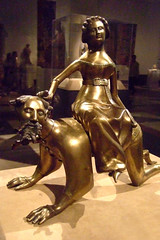 Image by mharrsch via Flickr Image by mharrsch via Flickr |
| A rather whimsical Aquamanile depicting Airstotle's girlfriend Herpyllis riding him around the garden after Aristotle warned Alexander the Great about women Copper Alloy South Lowlands 14th century CE |
I was particularly struck by the author's description of the death bed scene upon Aristotle's return from Chaeronea. Pythias is drifting in and out of consciousness as Aristotle sits by her bedside. Then Pythias begins rasping in the final death throes and Aristotle coldly leaves the room to go to the kitchen for a drink of water. When he returns to the room, his wife is dead. He seems relieved it is over and can now get back to work. Throughout the book, Lyon's Aristotle expresses little emotion over the death of friends or family members. He shows no grief over the death of his parents from the plague, the loss of his wife or the murder of his childhood "friend" Phillip II. When Phillip is assassinated, Aristotle retreats, along with his "nephew" Callisthenes to the library to avoid being a victim of any out-of-control retributions. It's as if his psyche is missing a limb.
But Aristotle himself would not view this emotional remoteness as a shortcoming, but an asset that allowed him to endure life's natural course of events and still focus on theoretical contemplation - an activity that he held up as the highest form of eudaimonia - happiness or well being (Nicomachean Ethics X.7). He would have viewed his display of unfeeling behavior as a virtuous choice between the extremes of excess and deficiency - the ever elusive "Golden Mean".
In the course of the narrative, Aristotle attempts to describe the concept of the "Golden Mean' to Alexander and the boy immediately makes the connection to the reason behind Aristotle's appointment as his tutor. Alexander's father, Phillip is the consummate warrior. What better choice to balance his education thereby achieving the "Golden Mean" than to appoint Aristotle, the consummate philosopher?
So, as the novel ends with Alexander leaving to begin his conquest of Asia and Aristotle seeking a sterile cocoon of contemplation in his hometown of Stagira, we must ask ourselves, did Aristotle succeed in shaping Alexander into "The Golden Mean", a philosophical warrior king, balanced between conqueror and contemplative statesman?
Other resources:
Introduction to Aristotle by S. Marc Cohen, Department of Philosophy, University of Washington
Collateral Damage: How Can the Army Best Serve a Soldier With Post-Traumatic Stress Disorder by Colonel Richard B. O’Connor, USA, Deputy Chief, Distribution Division, J-4 (Logistics), Joint Staff, the Pentagon.
Bryn Mawr Classical Review of From Melos to My Lai: War and Survival by Lawrence A. Tritle










